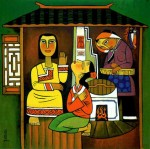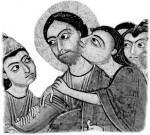I have been reading a couple of books on Church history as part of my formal studying. Both seemed to say a lot of the same stuff - but Rowan Williams was more succinct than Euan Cameron! I guess what struck me was that their focus on "continuity and change" seemed to centre on doctrine more than mundane everyday stuff. This makes me wonder am I being too trivial in what I'm thinking about - e.g. is change from not singing hymns to singing hymns (a C17 Baptist thing) actually all that important compared to say, what constitutes the 'true church' or the 'doctrine of God' or of 'God's mutability' (or otherwise). Then I start pondering how human mutability and divine immutability can possibly fit together (where my understanding of immutability is something about a 'still centre' not an impassive being). Then I think, hey, no one beyond academia will understand a word of this, and the whole point, surely is to be a PRACTICAL theologian, doing stuff that does relate to people in pews arguing about whether the green or red hymnbook is the one we ought to use...
I think that "continuity and change" is an important factor to hold in mind - Christianity has continued for a couple of thousand years and has evolved (am I allowed to use that word!) in all sorts of ways along the way. The 'kernel and husk' views of people like von Harnack clearly have a valid point - but what is the kernel, is it specific doctrines or is it a shared story? Is it something around liturgies and ordinances (or sacraments) or is it about mission? The contextual theologians who remind us about inculturation and aculturation pick on on some of the same threads.
All this is doing wonders for my 'I am thick' genes, makes me aware of how little I know about anything, about how much more I could/should read just to be able to articulate one simple thought.
So here's what I think I think today! Studying and trying to understand our past, the stories of how we got to where we are today, can be useful in appreciating something of the continuity and change that are part of our Christian heritage. Almost from the beginning, people have tried to work out what is essential to Christianity, and to church (not the same thing) and have fallen out over it more times than enough. Diversity and even (perceived) heresy are part of that story, orthodoxy seems often to be more about who shouted louder or lived longer than what or how they stood for - we have just forgotten that there was ever another viewpoint. A lot of theological energy goes into determining the essentials of Christianity and using this to determine what is a 'real' church; less perhaps goes into accepting that church exists and thinking about how church 'does' change. That church 'does' change has been true since it emerged, is true today as emergent churches, cell churches, you-name-it-it-does-it expressions of church come along. But who is looking at the process of change? Does one have to have a process theology of God (which I can never quite get to) to have a theology that says churches change? Is the doctrine of God at the heart of this? Or can I just say, actually we aren't very good at managing change, can we do it better? Which is what I want to think about when all is said and done.
So, lots of questions and no answers... now I need to get back to practical theology of sorting out the jobs that need to be done for our Pentecost Party, from chair shifting and tent pitching to what games are and are not permitted. All good fun - and "nothing changes here"!!!
 Martha - you know her, careworn red hands, face lined from frowning, always busy cooking and cleaning. Mary, beautiful, attentive, deeply spiritual... well that's the kind of images I grew up with anyway. So which one is it who recognises Jesus as who he is...? Why do Luke and John give us these seemingly contrasting portaits? Are they, in fact, contrasting? Or is it just that somewhere I have sold out to an unfair image of Martha (even if she's the one I feel more like, busy, practical and, when all's said and done, is making sure Jesus plus 12 hungry blokes and countless hangers on get the best dinner she can cook - yes, I know, that's Sunday School eisegesis or worse, but you get my drift).
Martha - you know her, careworn red hands, face lined from frowning, always busy cooking and cleaning. Mary, beautiful, attentive, deeply spiritual... well that's the kind of images I grew up with anyway. So which one is it who recognises Jesus as who he is...? Why do Luke and John give us these seemingly contrasting portaits? Are they, in fact, contrasting? Or is it just that somewhere I have sold out to an unfair image of Martha (even if she's the one I feel more like, busy, practical and, when all's said and done, is making sure Jesus plus 12 hungry blokes and countless hangers on get the best dinner she can cook - yes, I know, that's Sunday School eisegesis or worse, but you get my drift). It has been an odd Easter, and I have resisted the temptations (a) to dwell on what has miffed me (b) to criticise what I've experienced in services and (c) to post anything until my last commitment was complete. There is a lot I could say - a lot that found its way into my paper (and now rarely used) journal but I want to post on one train of thought only.
It has been an odd Easter, and I have resisted the temptations (a) to dwell on what has miffed me (b) to criticise what I've experienced in services and (c) to post anything until my last commitment was complete. There is a lot I could say - a lot that found its way into my paper (and now rarely used) journal but I want to post on one train of thought only.